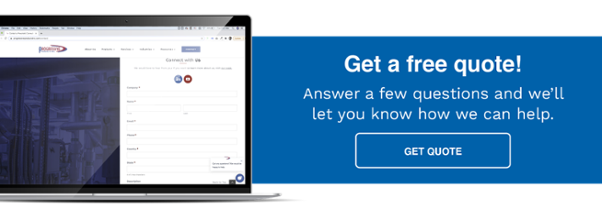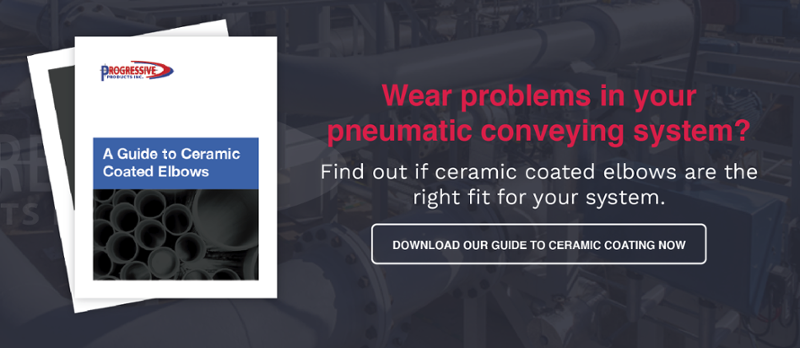If you use ceramic-coated elbows in your pneumatic conveying system, you’ll probably find that abrasion is greatly reduced, your elbows last longer, and you spend less time and money on maintaining your system.
That’s because ceramic coatings are incredibly hard and make your elbows more resilient to abrasion, wear, and impact than bare elbows.
Ceramic coating has the following functions in a pneumatic conveying system:
- Protects against abrasive wear from particles
- Reinforces components such as ceramic-coated elbows
- Increases the lifetime of your elbows
- Eliminates unwanted costs such as maintenance, loss of material, and system downtime
Why the Design of your System Might mean you need Ceramic-Wrapped Elbows
Pneumatic conveying systems rely on the fluid dynamics of air to convey particulate solids from one place to another. Different factors affect conveyance, and depending on the design of your system, there might be weaker points in some locations which require some kind of reinforcement due to abrasion.
Factors which may require you to include abrasion-resistant solutions such as ceramic-wrapping your pipes or tubes include:
- How the airflow and turbulence in your system affects the flow of product
- The combination of air pressure and speed you need to safely and efficiently convey your product
- The product itself - some types of solids, such as pet food, must be carefully handled to avoid crumbling (friability)
- Friction due to the abrasive action of particulate solids against your pipes
- The shape and size of your pipes and fittings
- The stress and strain limits of your elbows
About Ceramic Coating
Ceramic coating refers to to the external placement of ceramic compound. The external coating provides an extra layer of protection to the elbows and provides structural support.
Ceramics are resistant to high temperature, abrasion, and impact. These properties make them ideal as protective layers. The ones used in pneumatic conveying systems are engineered ceramics. They are typically metal oxides, carbides (e.g. tungsten carbide) or nitrides.
Common uses of Ceramic Coating in a Pneumatic Conveying System
Ceramic coatings in a pneumatic conveying system are mainly linings and wrappings. Various components that are extensively exposed to abrasion and impact need ceramic coating.
As a protective layer, ceramic is used as a coating for:
- Elbows – ceramic is either applied externally or internally on the outside curve of the elbow as this is the area most exposed to abrasion and impact. On occasion the inside curve will be exposed to abrasion. In these cases ceramic coating can be applied to the inside to protect this area.
- Other fittings – ceramic coating is applied to other types of pneumatic conveying fittings (laterals, tees, wyes) that are also exposed to abrasion.
Industries that benefit from using ceramic coated elbows include:
- Heavy industry - due to the nature of fly ash and aggregates such as chemicals, minerals, sand, and metal shavings, the main challenge for heavy industries is abrasive wear and impact on their pneumatic conveying elbows and fittings
- Grain - using ceramic-coated elbows to convey grain helps to maintain its quality and lessen the impact of abrasion
- Dry food and pet food - the main challenge these industries is abrasive wear. The need to frequently replace elbows isn’t ideal in terms of system downtime, cost, lost product, contamination potential, and resource>> (see below)
Some industries that benefit from using ceramic coated elbows include: heavy industries, grain and dry foot and pet food. The main challenge for these industries is abrasive and impact wear on their pneumatic conveying elbows and fittings. The need to frequently replace elbows isn’t ideal in terms of system downtime, cost, lost product, contamination potential, and resource
If you need help in selecting the right elbows for your pneumatic conveying system, it’s best to talk with an expert so you can ensure you get the correct components for your needs.
At Progressive Products, we won’t sell you anything you don’t need – contact us today to find the right solution for you.



